
Ulmus davidiana var. japonica, the Japanese elm, is one of the larger and more graceful Asiatic elms, endemic to much of continental northeast Asia and Japan, where it grows in swamp forest on young alluvial soils, although much of this habitat has now been lost to intensive rice cultivation.

The grey-eyed bulbul is a species of songbird in the bulbul family, Pycnonotidae. It is found in Southeast Asia in its natural habitat of subtropical or tropical moist lowland forests.

The white-bellied spinetail is a species of bird in the family Furnariidae. It is found in river islands of the western Amazon Basin. Its natural habitat is subtropical or tropical moist shrubland.

Coneweb spiders (Diguetidae) are six-eyed haplogyne spiders that live in tangled space webs, fashioning a cone-like central retreat where they hide and lay eggs. It is a small family, containing only two genera with fifteen species and is confined to the New World, preferring deserts. Members of the genus Diguetia usually build their webs in shrubs or between cactus pads. They have the same eye arrangement as the venomous recluse spiders, but none are known to be harmful to humans.

Thecophora is a genus of thick-headed fly from the family Conopidae.

Hakea propinqua is a common shrub found in heathlands near Sydney, New South Wales, Australia. It has sharp, needle-shaped leaves, white unpleasantly scented flowers and large warty fruit.

Spatalla is a genus containing 20 species of flowering plants, commonly known as "spoons", in the family Proteaceae. The genus is endemic to the Cape Floristic Region of South Africa where it is associated with fynbos habitats. The species are all small shrubs. The name is derived from the Greek, meaning “wantonness”, alluding to the plants’ unusually large pollen-presenters. Most species are threatened.
Glaenocorisa propinqua is a species in the family Corixidae, in the order Hemiptera . The distribution range of Glaenocorisa propinqua includes Europe & Northern Asia and North America.
Tumidagena minuta is a species of delphacid planthopper in the family Delphacidae. It is found in North America.
Euryneura propinqua is a species of soldier flies in the family Stratiomyidae.
Glaenocorisa is a genus of water boatmen in the family Corixidae. There are at least 2 described species in Glaenocorisa.

Metadelphax propinqua is a species of delphacid planthoppers in the family Delphacidae. It is found in Africa, Australia, the Caribbean, Europe & Northern Asia, Central America, North America, Oceania, South America, and Southern Asia.

Eudioctria is a genus of robber flies in the family Asilidae. There are about 14 described species in Eudioctria.
Tumidagena is a genus of delphacid planthoppers in the family Delphacidae. There are at least three described species in Tumidagena.
Eudioctria propinqua is a species of robber flies in the family Asilidae.

Formica propinqua is a species of ant in the family Formicidae.
Chlorixanthe propinqua is a species of scarab beetle in the family Scarabaeidae.

Cerotainia is a genus of robber flies in the family Asilidae. There are at least 30 described species in Cerotainia.
Thecophora propinqua is a species of thick-headed flies, insects in the family Conopidae.
Quasimitra is a genus of sea snails, marine gastropod mollusks in the family Mitridae.










